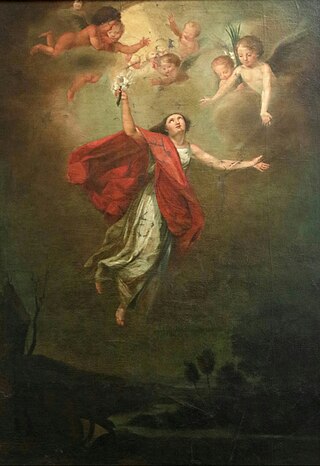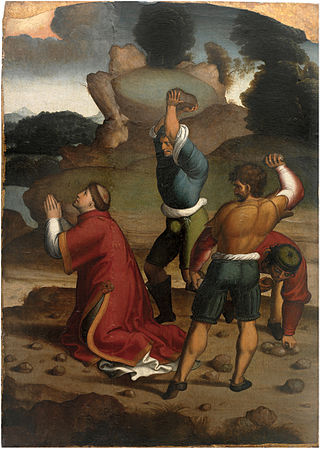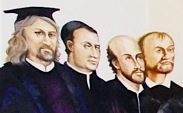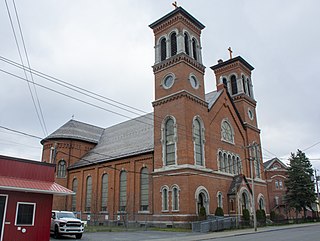Related Research Articles

Pope Stephen I was the Bishop of Rome from 12 May 254 to his death on 2 August 257. He was later canonized as a saint and some accounts say he was killed while celebrating Mass.

Pope Felix I was the bishop of Rome from 5 January 269 to his death on 30 December 274. Born in Rome, he succeeded Pope Dionysius and is noted for his theological contributions, particularly a significant dogmatic letter addressing the unity of Christ’s person. During his papacy, Felix I confronted the heresy of Paul of Samosata, who denied the divinity of Christ. The intervention of Emperor Aurelian, prompted by Felix, led to Paul’s deposition from the bishopric of Antioch, reinforcing orthodox Christological doctrine.

Pope Lucius I was the bishop of Rome from 25 June 253 to his death on 5 March 254. He was banished soon after his consecration, but gained permission to return. He was mistakenly classified as a martyr in the persecution by Emperor Valerian, which did not begin until after Lucius' death.

Philomena, also known as Saint Philomena or Philomena of Rome was a virgin martyr whose remains were discovered on May 24–25, 1802, in the Catacomb of Priscilla. Three tiles enclosing the tomb bore an inscription, Pax Tecum Filumena, that was taken to indicate that her name was Filumena, the English form of which is Philomena. Philomena is the patron saint of infants, babies, and youth, and is known as "The Wonderworker".

The Paschal Triduum or Easter Triduum, Holy Triduum, or the Three Days, is the period of three days that begins with the liturgy on the evening of Maundy Thursday, reaches its high point in the Easter Vigil, and closes with evening prayer on Easter Sunday. It is a moveable observance recalling the Passion, Crucifixion, Death, burial, and Resurrection of Jesus, as portrayed in the canonical Gospels.

The Korean Martyrs were the victims of religious persecution against Catholics during the 19th century in Korea. Among them are 103 Saints and 124 Blesseds officially recognized by the Catholic Church.

In Christianity, a martyr is a person who was killed for their testimony for Jesus or faith in Jesus. In the years of the early church, stories depict this often occurring through death by sawing, stoning, crucifixion, burning at the stake, or other forms of torture and capital punishment. The word martyr comes from the Koine word μάρτυς, mártys, which means "witness" or "testimony".

The Forty Martyrs of England and Wales or Cuthbert Mayne and Thirty-Nine Companion Martyrs are a group of Catholic, lay and religious, men and women, executed between 1535 and 1679 for treason and related offences under various laws enacted by Parliament during the English Reformation. The individuals listed range from Carthusian monks who in 1535 declined to accept Henry VIII's Act of Supremacy, to seminary priests who were caught up in the alleged Popish Plot against Charles II in 1679. Many were sentenced to death at show trials, or with no trial at all.

Finnian of Movilla was an Irish Christian missionary. His feast day is 10 September.

Saints Chrysanthus and Daria are saints of the Early Christian period. Their names appear in the Martyrologium Hieronymianum, an early martyrs list, and a church in their honour was built over their reputed grave in Rome.

The Four Crowned Martyrs or Four Holy Crowned Ones were nine individuals who are venerated as martyrs and saints of Early Christianity. The nine saints are divided into two groups:
- Severus, Severian(us), Carpophorus (Carpoforus), Victorinus
- Claudius, Castorius, Symphorian (Simpronian), Nicostratus, and Simplicius
The 26 Martyrs of Japan were a group of Catholics who were executed by crucifixion on February 5, 1597, in Nagasaki, Japan. Their martyrdom is especially significant in the history of the Catholic Church in Japan.

Irish Catholic Martyrs were 24 Irish men and women who have been beatified or canonized for both a life of heroic virtue and for dying for their Catholic faith between the reign of King Henry VIII and Catholic Emancipation in 1829.

Polydore Plasden (1563–1591) was one of the Catholic Forty Martyrs of England and Wales. A native of London, he studied for the priesthood at Rheims and Rome, and was ordained in 1586 before being sent back to England soon after.

Christians were persecuted throughout the Roman Empire, beginning in the 1st century AD and ending in the 4th century. Originally a polytheistic empire in the traditions of Roman paganism and the Hellenistic religion, as Christianity spread through the empire, it came into ideological conflict with the imperial cult of ancient Rome. Pagan practices such as making sacrifices to the deified emperors or other gods were abhorrent to Christians as their beliefs prohibited idolatry. The state and other members of civic society punished Christians for treason, various rumored crimes, illegal assembly, and for introducing an alien cult that led to Roman apostasy. The first, localized Neronian persecution occurred under Emperor Nero in Rome. A number of mostly localized persecutions occurred during the reign of Marcus Aurelius. After a lull, persecution resumed under Emperors Decius and Trebonianus Gallus. The Decian persecution was particularly extensive. The persecution of Emperor Valerian ceased with his notable capture by the Sasanian Empire's Shapur I at the Battle of Edessa during the Roman–Persian Wars. His successor, Gallienus, halted the persecutions.

The altar in the Catholic Church is used for celebrating the Sacrifice of the Mass.

Mehtab Singh was a Sikh warrior and martyr.

St. Joseph's Church, also known as St. Joseph & St. Patrick Church, is a historic Roman Catholic church complex at 704-708 Columbia Street in Utica, Oneida County, New York. The complex consists of the church, St. Joseph's Parochial School (1885), St. Joseph's Parochial Residence (1906), and Parish Convent building (1891). The parish is part of the Roman Catholic Diocese of Syracuse.

Saint Stephen Martyr Catholic Church is a Catholic parish church located at 2436 Pennsylvania Avenue NW in Washington, D.C., in the United States. The parish was founded on August 4, 1867, and the first church building consecrated and used for worship on December 27, 1868. This brick structure closed on July 15, 1959, and the current new building was consecrated and first used for worship on June 11, 1961. The church was a favorite of President John F. Kennedy.
References
- ↑ Herbermann, Charles, ed. (1913). . Catholic Encyclopedia . New York: Robert Appleton Company.
- ↑ "The Holy Martyrs of Utica, Called the White Mass" . Retrieved 2024-12-07.